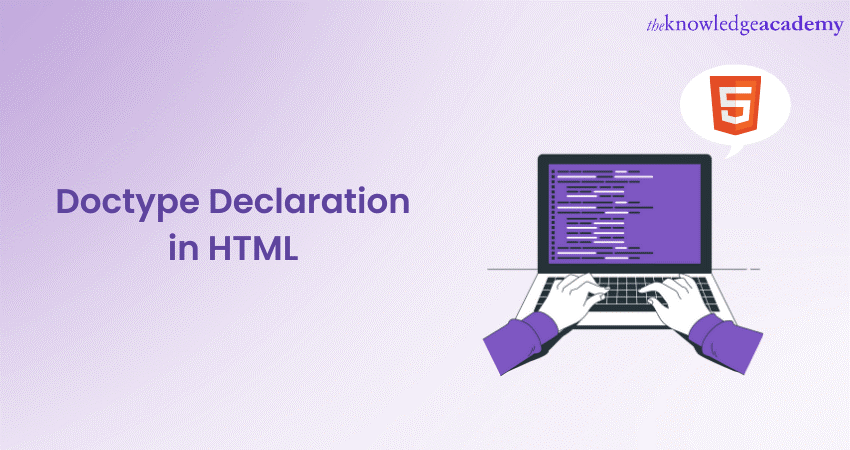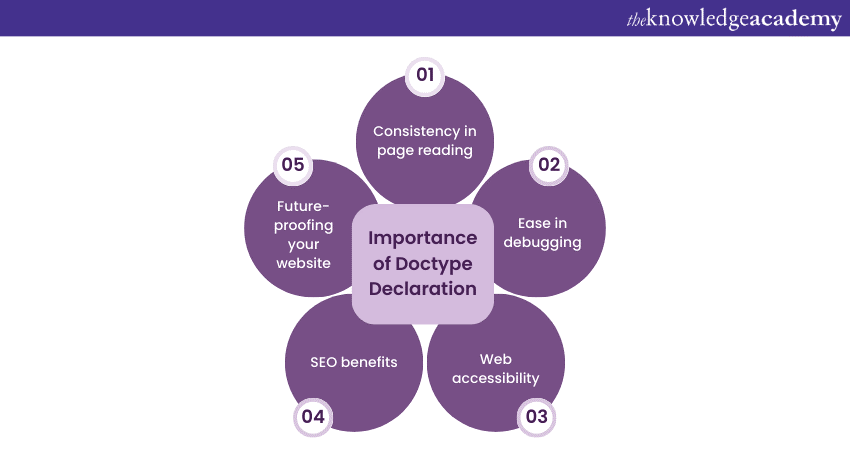We may not have the course you’re looking for. If you enquire or give us a call on 01344203999 and speak to our training experts, we may still be able to help with your training requirements.
Training Outcomes Within Your Budget!
We ensure quality, budget-alignment, and timely delivery by our expert instructors.

Before the Doctype Declaration in HTML, web development faced many inconsistencies due to differing browser interpretations of HTML. Developers often resorted to browser-specific hacks, making code hard to maintain. The introduction of Doctype standardised browser rendering reduces the need for browser-specific fixes and increases consistency.
Different browsers have different ways of rendering web pages. When you include a Doctype, you help standardise how browsers interpret your website's HTML code. In this blog, we will learn how Doctype Declaration in HTML ensures consistent rendering of web pages across different browsers.
Table of Contents
1) What is Doctype HTML?
2) Importance
a) Consistency in page rendering
b) Ease in debugging
c) Web accessibility
d) SEO benefits
e) Future-proofing your website
f) Cross-browser compatibility
g) Avoiding quirks mode
h) Adherence to best practices
i) Enables modern CSS and JavaScript features
3) Usage
4) Conclusion
What is Doctype HTML?
The declaration is a preamble in HTML5 documents. It informs the web browser about the version of HTML used. This statement should appear at the top of an HTML document. It helps ensure that browsers render the page as intended. Unlike HTML tags, the Doctype Declaration doesn't affect the page's appearance.
Instead, it provides metadata to the browser. Its primary role is to prevent browsers from going into "quirks mode." In this mode, browsers use an outdated rendering engine, which can lead to inconsistencies. By specifying the Doctype, you enable "standards mode," helping the browser interpret your code more accurately.
Unlock the power of HTML for better web development with The Knowledge Academy's Introduction to HTML course.
Importance
The Doctype Declaration serves multiple functions that are crucial for web development and the user experience. From ensuring consistent rendering across browsers to helping with SEO, the benefits are manifold. The following subheadings delve into why it's indispensable to include the Doctype Declaration in your HTML documents.

Consistency in page rendering
The Doctype Declaration ensures that your webpage renders consistently. Without it, browsers enter "quirks mode," causing layout problems. This can result in visual and functional issues, affecting user experience negatively.
Ease in debugging
Debugging becomes more straightforward with the correct Doctype. Web developer tools assume "standards mode" by default. Omitting the Doctype could lead to unexpected issues during debugging.
Web accessibility
The Doctype also plays a role in web accessibility. Browsers interpret ARIA roles and accessibility features better in "standards mode." This is important for users who rely on assistive technologies like screen readers.
SEO benefits
Search engines favour websites that adhere to web standards. A correct Doctype contributes to better SEO, leading to higher rankings and more visibility for your site.
Future-proofing your website
Adding the correct Doctype prepares your site for future web standards. Browsers continuously update to align with new rules. Using the right Doctype keeps your site compatible with these changes.
Elevate your tech skills with The Knowledge Academy's diverse range of App and Web Development courses.
Cross-browser compatibility
The Doctype aids in making your website cross-browser compatible. Different browsers have unique rendering engines. The Doctype helps to standardise how these engines interpret your website's code.
Avoiding quirks mode
Quirks mode can distort the design and functionality of a website. It makes browsers use outdated rendering rules. By setting the right Doctype, you avoid this pitfall.
Adherence to best practices
Including a Doctype is also considered a best practice in web development. It shows that you're aware of the importance of following web standards. This can be especially important for professional developers.
Enables modern CSS and JavaScript features
In "standards mode," browsers can utilise the full range of modern CSS and JavaScript features. Without the correct Doctype, some of these capabilities may not work as expected.
Usage
Understanding how to properly use the Doctype Declaration is essential for successful web development. From its positioning in an HTML document to its impact on the DOM, the following subheadings offer insights into its correct usage.
Positioning in the document: The Doctype Declaration should be the very first thing in your HTML document. Place it before the opening
tag to set the document type.
Syntax: The correct syntax for an HTML5 Doctype Declaration is . This is case-insensitive, but it's good practice to follow this standard casing.
Older HTML versions: For older versions of HTML like 4.01, different Doctype Declarations exist. Always match the Doctype with the HTML version you're using.
XHTML considerations: In XHTML documents, you'll use a slightly different Doctype. For example, for XHTML 1.0 Strict, the Doctype is .
Templates and IDEs: Modern development environments often include the Doctype in their HTML templates. This helps you start with a correctly structured document.
HTML validators: Using HTML validators can help confirm that you've properly implemented the Doctype. Validators check for errors and compliance with web standards.
Impact on DOM: Although Doctype doesn't directly affect the appearance of a page, it does influence the Document Object Model (DOM). The DOM becomes more predictable with the correct Doctype.
Changing Doctype: If you're updating an older website, changing the Doctype to HTML5 is usually straightforward. However, review your code to ensure it aligns with HTML5 standards.
No closing tag: The Doctype Declaration is a standalone element. It doesn't require a closing tag, unlike many HTML elements.
Warnings and errors: Browsers generally don't display an error if you omit the Doctype. However, you might notice inconsistencies in page rendering as a result.
Conclusion
With the evolution of HTML, CSS, and JavaScript, new features are constantly being added to make web development more robust and interactive. A correct Doctype Declaration in HTML allows browsers to render modern features as intended. This ensures that users experience the web at its best.
Take your game development to the next level with The Knowledge Academy's HTML 5 Apps and Game Training.







 Top Rated Course
Top Rated Course




 If you wish to make any changes to your course, please
If you wish to make any changes to your course, please


